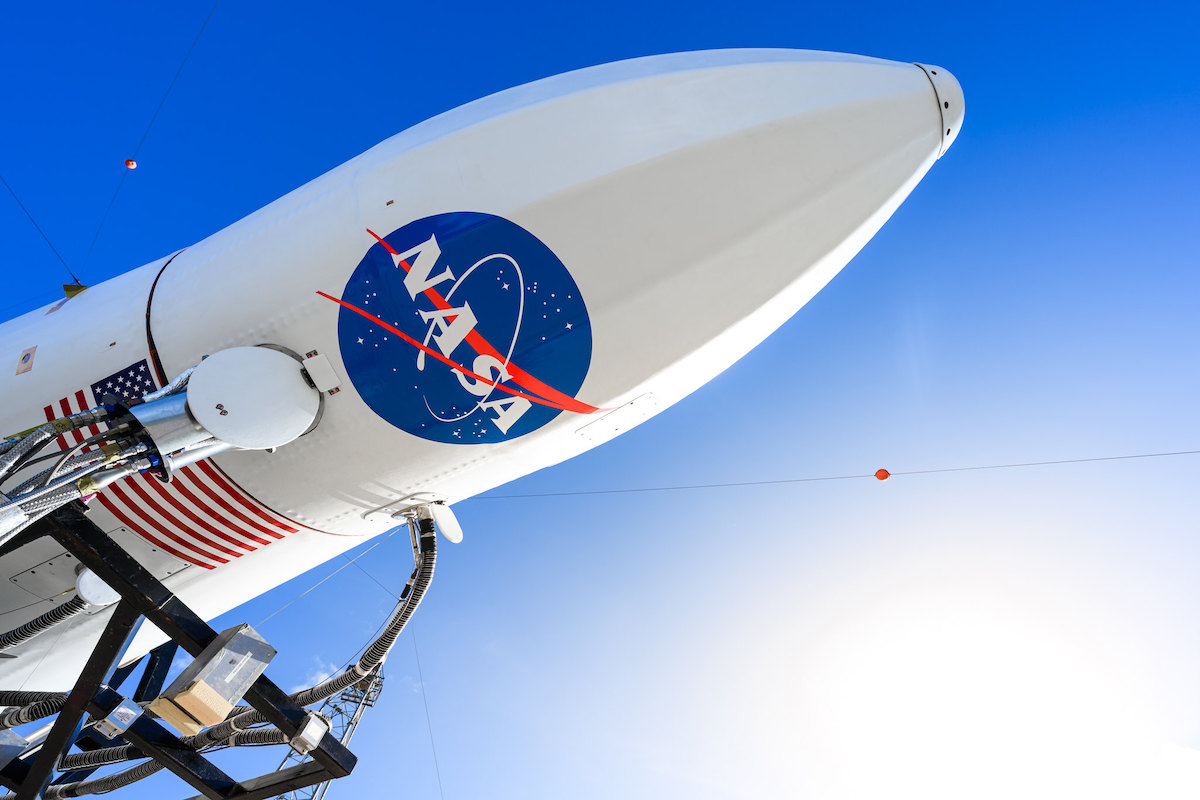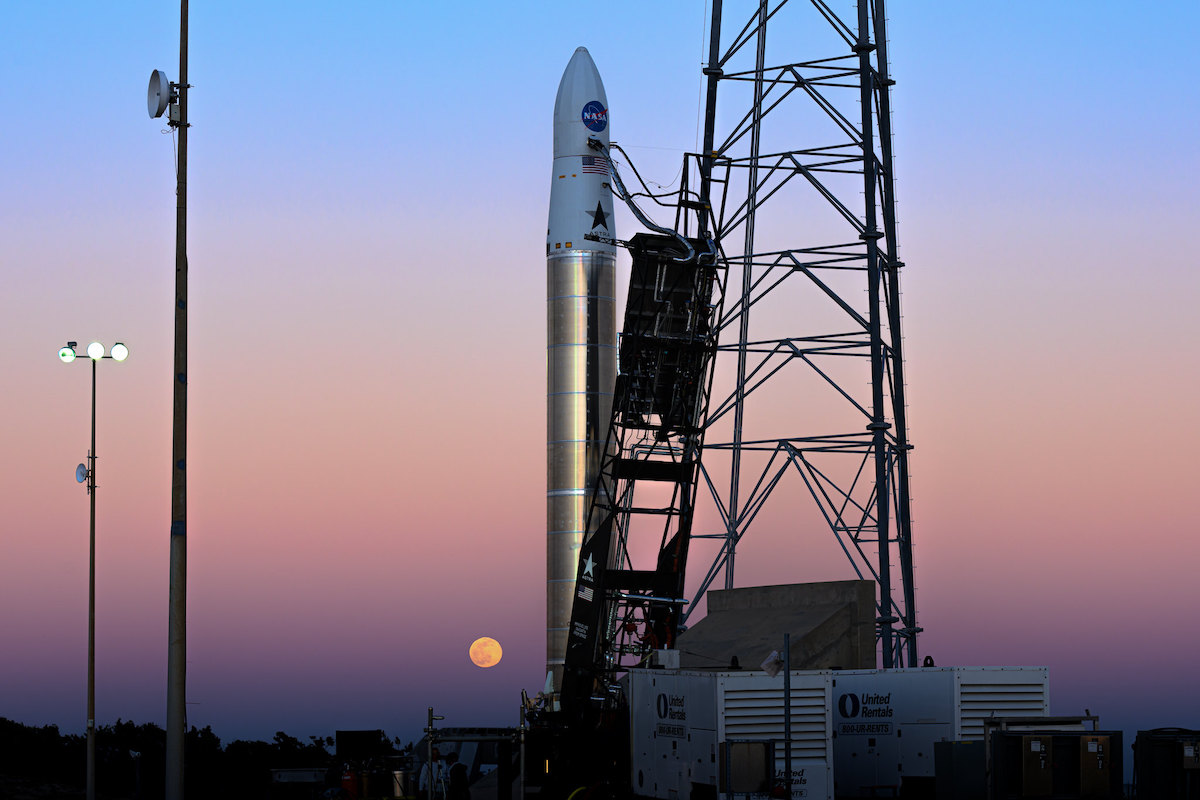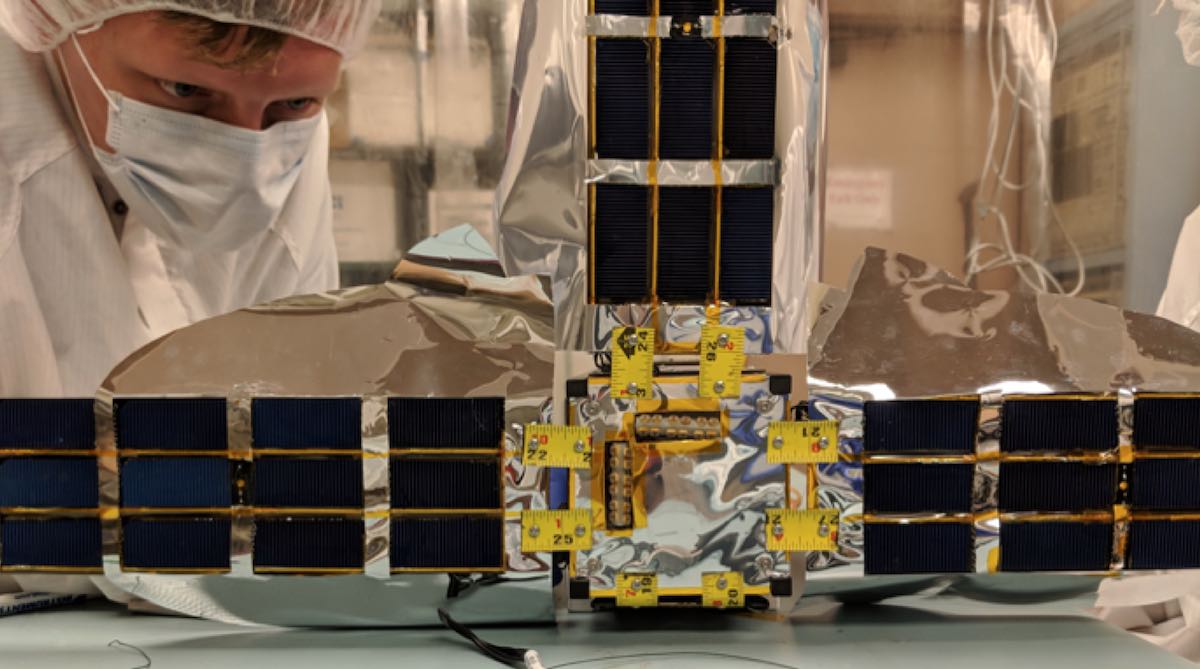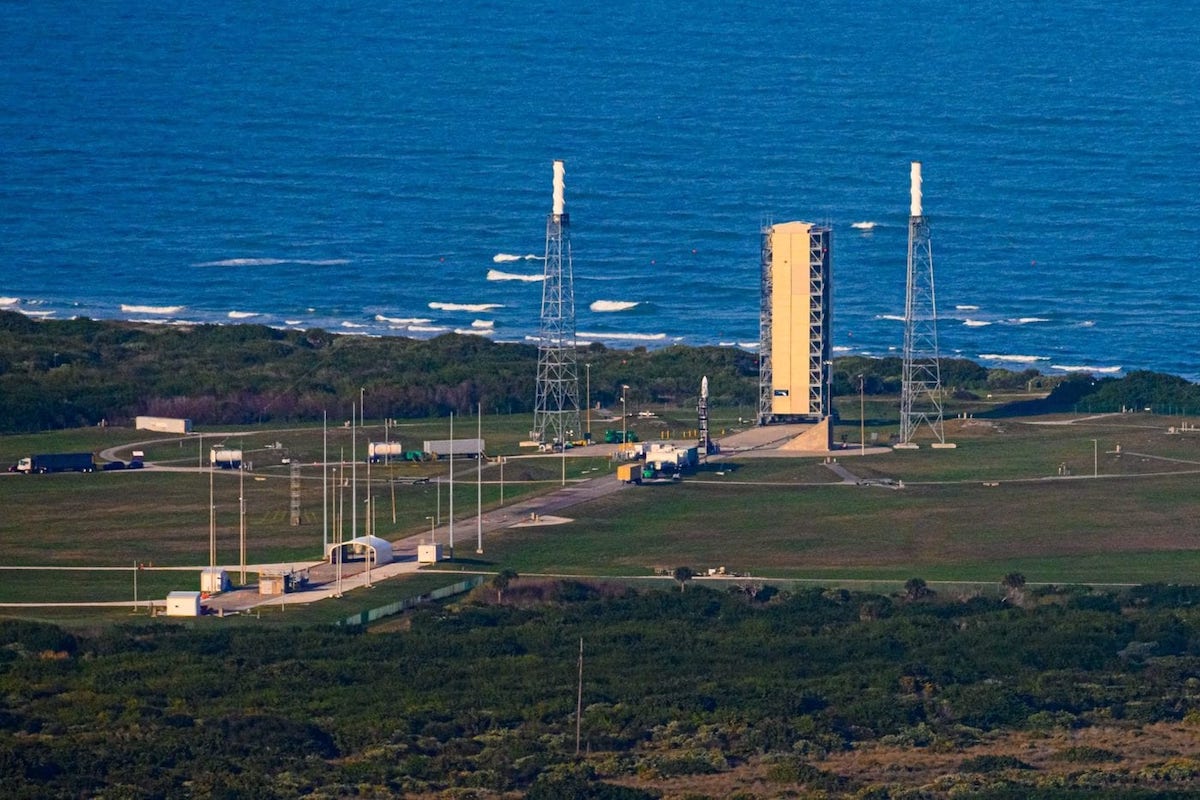
Astra has become the first company to receive a commercial launch license from the Federal Aviation Administration through a streamlined regulatory regime, clearing a procedural hurdle before launching a small rocket and four NASA-sponsored CubeSats into orbit Saturday from Cape Canaveral.
The company has a three-hour launch window Saturday opening at 1 p.m. EST (1800 GMT) for a two-stage booster Astra calls simply “Rocket 3.3” or “LV0008.”
Astra’s small launcher on Space Launch Complex-46 at Cape Canaveral Space Force Station will be loaded with kerosene and liquid oxygen in the final hour of its countdown, controlled by a team of engineers based across the country the company’s headquarters in Alameda, California.
There is a 60% chance of favorable weather for launch Saturday, according to the U.S. Space Force’s 45th Weather Squadron. The primary weather concerns are with cumulus clouds and ground winds after a weak cold front passes through the Space Coast on Saturday morning.
During the launch window, forecasters expect a few rain showers in the area, an overcast sky, winds from the north at 15 to 20 mph, and a temperature of around 66 degrees Fahrenheit.
The mission scheduled for launch Saturday will be Astra’s first flight from Cape Canaveral, following prior test flights from Kodiak Island, Alaska. Astra’s small expendable launcher reached orbit from Alaska for the first time in November with a dummy payload for the Space Force.
The successful test flight in November followed three previous launch attempts that faltered before accelerating to orbital velocity.
Now Astra is set for its first mission to loft functioning satellites, working under the auspices of a $3.9 million contract with NASA’s Venture Class Launch Services program. Four CubeSats, each about the size of a shoebox or toaster oven, are stowed inside the rocket’s payload shroud for liftoff Saturday.
Astra’s rocket is small in comparison to other launch vehicles that fly from Cape Canaveral. The Rocket 3.3 vehicle stands 43 feet (13.1 meters) tall and measures 52 inches (1.3 meters) in diameter. It’s five times shorter than SpaceX’s Falcon 9 rocket, and about the same height as the payload compartment on top of the Falcon 9.
The rocket is sized to haul payload of up to 110 pounds (50 kilograms) into a 310-mile-high (500-kilometer) orbit, according to Astra, one of numerous launch companies eyeing the growing small satellite market.
Astra’s rocket will be the smallest orbital-class launcher to ever fly from Cape Canaveral, and it is one of the smallest satellite launchers in the world.
The FAA launch license clears the way for Astra to proceed with Saturday’s launch attempt. The company announced Friday it had received the license under what the FAA calls Part 450, a licensing process that combines four regulations into a single rule governing commercial launch and re-entry operations.
The new licensing regime gives more flexibility to commercial spaceflight operators, and moves from a “prescriptive” regulatory approach to one that is more “performance-based,” according to the FAA, which developed the streamlined regulation in response to Space Policy Directive 2 signed by former President Donald Trump.
Under Part 450, companies can more easily launch from different launch pads and spaceports. It’s also easier for an operator to apply for and receive a single license to conduct multiple launches of the same type of rocket.
“Astra is proud to be the first company to receive a Part 450 license, and we plan to continue leveraging the full potential of Part 450’s flexibility,” wrote Tom Marotta, Astra’s principal launch licensing manager. “Our existing license can be modified to add more launch sites, along with new launch vehicles.”
“Flexibility is critical to the commercial space industry—and especially to Astra, as we work towards our goal of daily launches,” Marotta wrote. “Astra applauds the FAA for taking steps to introduce more flexibility with Part 450, paving the path to greater innovations in spaceflight.”
The new regulatory regime also allows the FAA to better keep up with the rapid growth of the commercial space industry. The FAA is responsible for ensuring public safety during commercial launch and re-entry operations by U.S. companies, and requires operators to purchase insurance to cover potential third-party damages.
According to the FAA’s website, the agency licensed 54 commercial space launches in 2021, and has licensed six to start 2022. In 2011, the FAA says there was just one licensed commercial space launch.

Astra’s first launch from Cape Canaveral will aim to place into orbit three university-built CubeSats and one nanosatellite developed at NASA’s Johnson Space Center.
Five kerosene-fueled Delphin first stage engines will throttle up to generate 32,500 pounds of thrust at full power. SpaceX’s Falcon 9 rocket produces 50 times more thrust at liftoff.
Astra’s rocket is built to provided dedicated rides to orbit for small commercial, military, and scientific spacecraft. SpaceX is going after the same small satellite launch market, but it aggregates large numbers of payloads on a single Falcon 9 rocket.
That strategy results in savings in launch costs for satellite companies. The drawback is each customer has no control over the launch schedule or orbital parameters for each Falcon 9 rideshare mission.
After liftoff from Cape Canaveral, Astra’s 43-foot-tall rocket will head northeast over the Atlantic Ocean. The first stage will shut down its engines at T+plus 2 minutes, 50 seconds, followed five seconds later by stage separation.
A second stage Aether engine, also burning kerosene fuel, will fire for nearly six minutes to reach a target orbit at an altitude of 310 miles and an inclination of 41 degrees to the equator.
The four CubeSats on-board the rocket are scheduled to deploy at T+plus 8 minutes, 40 seconds.
The four nano-payloads are part of NASA’s Educational Launch of Nanosatellites, or ELaNa, program. The CubeSats flying on the Astra mission were in a pool of dozens of prospective smallsats drawn from the agency’s CubeSat Launch Initiative.
One of the CubeSats was developed by the University of California, Berkeley. Named QubeSat, the small spacecraft will test a tiny gyroscope, a device used to help determine the orientation of satellites in space.
Another student-developed payload on Astra’s first launch from Florida is the Ionospheric Neutron Content Analyzer, or INCA mission, from New Mexico State University. INCA’s main science instrument is a directional neutron spectrometer from NASA’s Goddard Space Flight Center.
Data from INCA will “contribute to understanding the radiation environment that satellites encounter, and to the understanding of neutron air showers, which pose a radiation hazard to occupants of high-altitude aircraft such as airliners,” according to the student team that developed the mission.
The BAMA 1 mission, developed at the University of Alabama, will demonstrate a drag sail device designed to help old satellites and space junk drop out of orbit. The drag sail will encounter air molecules from the rarefied atmosphere at the satellite’s altitude, slowing its velocity enough to fall back to Earth.
The final payload is a CubeSat named R5-S1 from NASA’s Johnson Space Center in Houston. NASA says the mission’s objectives including demonstrating quick CubeSat development and testing technologies useful for in-space inspection, which could make human spaceflight safer and more efficient.

Another CubeSat mission from UC-Berkeley originally selected by NASA for the Astra demonstration launch wasn’t ready in time for integration with the rocket in December, according to Jasmine Hopkins, a NASA spokesperson at Kennedy Space Center.
The CubeSat Radio Interferometry Experiment, or CURIE, mission, consists of two identical three-unit CubeSats, each the size of a shoebox, with radio antennas to detect emissions from solar activity, such as solar flares and coronal mass eruptions.
NASA will assign the CURIE satellites to another launch, Hopkins said.
NASA purchased the Astra rocket launch in December 2020 as a demonstration flight under the agency’s Venture Class Launch Services program.
The Venture Class Launch Services program is aimed at giving emerging small satellite launch companies some business, while helping NASA officials familiarize themselves with the nascent industry.
NASA previously awarded VCLS demonstration missions to Rocket Lab and Virgin Orbit, which completed their first launches for the U.S. space agency in 2018 and 2021. NASA announced a new round of VCLS contracts to Astra, Firefly Aerospace, and Relativity Space in 2020.
The U.S. military has awarded similar demonstration launch contracts to Astra and other companies.
Scott Higginbotham, head of NASA’s CubeSat Launch Initiative at Kennedy Space Center, said the VCLS mission gives the space agency insight into companies’ management and technical teams, procedures and processes, and their hardware designs.
“That’s going to allow us to be a better consumer going forward if they stay in business, and can offer their services to us later on,” Higginbotham said in an interview in November. “We’ll already have been introduced and have done a deep dive, of sorts, into those companies to understand what makes them tick, and that’s of tremendous value to us.”
The VCLS demo missions are also a stepping stone toward certification of the new smallsat launchers to carry more expensive NASA satellites into orbit. The certification isn’t required for the demo missions themselves.
“NASA has other missions that require a little bit more reliability from the launch vehicle, a little more certainty, and a little more launch vehicle insight,” Higginbotham said.
Last month, NASA announced it selected 12 companies to provide launch services for the agency’s growing number of CubeSats and other small satellite projects. The Venture-Class Acquisition of Dedicated and Rideshare, or VADR, program is a follow-on to the Venture Class Launch Services demonstration missions.
Astra was one of the 12 companies selected for the VADR program, along with ABL Space Systems, Blue Origin, L2 Solutions, Northrop Grumman, Phantom Space, Relativity, Rocket Lab, Spaceflight, SpaceX, United Launch Alliance, and Virgin Orbit.
L2 Solutions and Spaceflight are launch brokers, acting as agents matching satellites with a wide range of rockets. The other VADR providers are currently flying or developing rockets of various sizes, capable of launching small satellites on dedicated missions or on rideshare launches.

Aside from its business with NASA, Astra has announced launch contracts with the U.S. military and commercial companies like Spire and Planet.
Founded in 2016, Astra designed its small satellite launcher to be transported inside a standardized shipping container. The company also ships mobile launch infrastructure from its California headquarters to each launch site.
The nimble nature of Astra’s launch operation allows the company to fly from austere launch sites, requiring only a flat concrete pad, electrical power, and an internet connection.
A team of fewer than a dozen technicians and engineers set up Astra’s rocket on pad 46 at Cape Canaveral last month. Data links between the launch pad and Astra’s headquarters in California allow engineers to remotely monitor launch preps from nearly 2,500 miles away.
Astra test-fired its rocket Jan. 22 on pad 46, igniting its five first stage engines for nearly 10 seconds while the launcher stayed fixed on the ground.
Pad 46, located near the easternmost extent of Cape Canaveral, is managed by Space Florida, a state-backed enterprise chartered to lure commercial space companies to the Sunshine State. The launch pad was originally developed as a test site for the Navy’s Trident missile, then converted for civilian use.
The facility was used for an abort system test on NASA’s Orion crew capsule in 2019, a Minotaur rocket launch with a military satellite in 2017, and the launch of NASA’s Lunar Prospector probe to the moon in 1998.
Email the author.
Follow Stephen Clark on Twitter: @StephenClark1.
